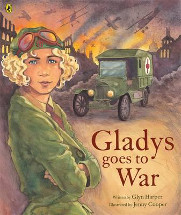Gladys goes to war by Glyn Harper
 Ill. by Jenny Cooper. Picture Puffin, 2016. ISBN 9780143507208
Ill. by Jenny Cooper. Picture Puffin, 2016. ISBN 9780143507208Auckland, New Zealand in the very early 20th century when girls were still supposed to be seen and not heard, despite having had voting rights since 1893 - still very much an English colonial mentality where they busied themselves with music, needlework and other "feminine" tasks. However, unlike her sisters, Gladys was not good at such things, preferring instead to spend her time under the bonnet of her brothers' cars and those of their friends.
"No one will want to marry a mechanic" her mother told her, echoing the feelings and the culture of the times. But her mother was wrong and in 1912 she met and married William Henning who taught her to drive and then set up a car sales business in Auckland. Being competent and comfortable in this "men's world" meant that it was no surprise that when her husband and brothers enlisted when World War I broke out that Gladys wanted to go too. But her efforts were met with the typical chauvinistic response of the times . . . "If you want to help the war effort, you should stay at home and knit socks and balaclavas."
But they had underestimated Gladys's determination and in 1916 with the assistance of the New Zealand Volunteer Sisterhood she was reunited with her husband in Egypt becoming an ambulance driver, and when he was sent to France she went to England. But again male-dominated bureaucracy determined her place was in the hospital scrubbing floors not driving ambulances. Until one evening, there was a shortage of drivers . . .
This is the story of just one of the many women who played an active part in World War I as doctors, nurses, ambulance drivers and so much more, rather than being the stereotype wife/mother/ sister/ daughter who 'kept the home fires burning'. Despite their important contribution throughout history, so many women have been written out of it and when a request through a local network for a book for younger readers about World War I from a female perspective there was a paucity of replies. Yet there are so many stories that could be told from both New Zealand and Australia.
Gladys was a pioneer in so many fields - in 1927, having survived both the war and Spanish flu, she and her friend Stella Christie became the first women to transverse Australia east to west and north to south in a car - and so bringing her wartime service to light is just the beginning of the stories that could be told about this remarkable woman. But as well as her personal chronicle, this could be a springboard for having students investigate and retell the stories of other women whose contributions have been overshadowed by those of their male counterparts. Searching the Australian War Memorial's site for "women in war" is a good starting point.
However, even if Gladys's story is just shared as a standalone, it is a sound representation of #nevertheless,shepersisted
Barbara Braxton